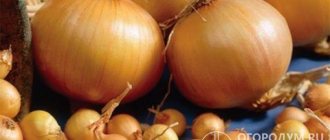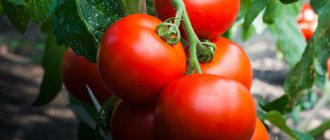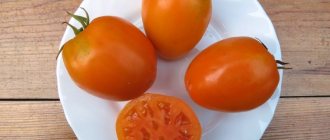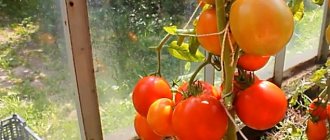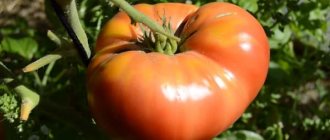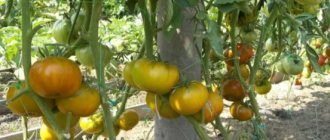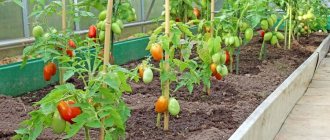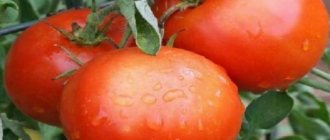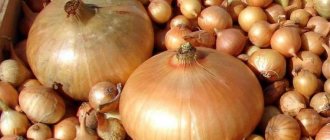It’s easy to get lost in the abundance of tomato varieties and hybrids these days. But the gardener usually knows exactly what he wants. True, he also wants to eat delicious fresh tomatoes, as early as possible, and put away a dozen or two jars for the winter. Can one variety fit all needs? Maybe there are universal tomatoes. And one of them is the Verlioka F1 hybrid.
- 2 Appearance
- 3 Advantages and disadvantages, features, differences from other varieties
- 4 Features of planting and growing Verlioka tomato
4.1 Landing
- 4.2 Caring for bushes in a greenhouse
4.2.1 Video: Verlioka tomato in a greenhouse
What is f1 hybrid
On the packages of some seeds, after the name of the variety there is an inscription in the form of F1; inexperienced gardeners have no idea that this variety of tomato is not a varietal, but a hybrid form.
In the abbreviation F stands for the first letter of the word children (filii), and the number stands for 1 - the first generation.
A hybrid is the crossing of several varieties, from which the new form obtains the best qualities. They have excellent qualities:
- precocity;
- disease resistance;
- unpretentiousness to soil and watering;
- high yield.
Some people don’t like hybrids because of their taste, saying that varietal varieties are tastier, but this is just everyone’s preference.
Hybrid seeds are always more expensive. This is explained by the fact that obtaining a hybrid requires several months of manual work.
Verlioka tomatoes on video
If you grew Verlioka tomatoes, please write whether you liked them or not. What was the yield and taste of the fruits like under your climatic conditions? How do you rate the disease resistance of this tomato? Briefly describe the advantages and disadvantages of this tomato in your opinion. If possible, attach a photo of the entire bush or individual fruits you grew to your comment. Thank you!
You can see other interesting varieties by looking through our Tomato Catalog with photos, reviews, descriptions. Enjoy watching!
Your reviews of the Verlioka f1 tomato and additions to the description will help many gardeners evaluate this hybrid more objectively and decide whether it is worth planting or not.
Description of the variety
Verlioka F1 tomatoes are a domestically developed hybrid. They were bred back in 1986 by Moscow breeders. After some tests, already in 1990 the hybrid was included in the State Register.
Appearance of plants
Verlioka tomatoes are a determinant variety. Early ripening tomato. The height of the plant is average, varying from 120 to 150 cm. Tomatoes have bright green leaves. Cultivated in greenhouses and film coverings.
The fruits of the plant are universal, suitable for consumption in any form. They have good taste and bright aroma.
Taste and description of fruits
Verlioka F1 is one of the best domestic hybrids. The fruits of the plant have a round shape, thick skin and gloss.
Sweet tomatoes taste slightly sour. The aroma is rich.
The weight of each fruit reaches 80-100 g, some up to 115 g.
Productivity
With proper care, the yield from each bush is 5-6 kg. That is about 20 kg. from 1 sq.m. During the period of active fruiting, the fruits cover almost all the foliage.
The hybrid is characterized by friendly ripening in any conditions. In this case, fruiting lasts until September. Even at this time, tomatoes can be harvested at technical ripeness.
Summarizing
Tomatoes Verlioka: photo of the variety
Many beginners are afraid to take on growing tomatoes because they consider this heat-loving crop to be too difficult.
So, you shouldn’t be afraid, there are varieties that even a novice gardener can cope with growing. These varieties include the Verlioka F1 tomato - a hybrid tomato that is unpretentious, does not get sick and will certainly delight you with an excellent harvest. So buy Verlioka tomato seeds and act, everything will work out. Tomato Verlioka: video about the variety
We grow seedlings
Verlioca tomato intended for growing in a greenhouse. The hybrid is grown exclusively through seedlings.
Seed preparation
Seed preparation is carried out in a standard way, as for other varieties.
From the available seeds, you need to choose the largest ones, from which healthy and strong plants will grow.
You can also check the germination of seeds by soaking them in a glass of warm water; those seeds that sink to the bottom are suitable for planting, but those that remain on the surface do not need to be planted, since these are dummies.
Before planting seeds in the ground, they must be disinfected. This can be done using a 15% solution of potassium permanganate. It will kill all germs, infections, etc. on the seeds. This will eliminate plant diseases at the early growth stage.
You can also use hydrogen peroxide 3%. This method will not only disinfect the seed, but also speed up the germination process.
Soil preparation
The quality of future seedlings depends on the soil. If the soil is of poor quality, the plant will have difficulty germinating. Do not use soil that is too wet for seedlings. If the soil is highly acidic, you need to add a little lime to it. Tomatoes do not like excessive acidity.
If you plan to purchase soil from a store, it is worth remembering that it must be calcined in the oven. This will allow you to destroy all harmful and dangerous bacteria.
In the case of using garden soil, the calcination process is also necessary. If you plan to make the soil yourself, it is recommended to mix the soil with humus and sawdust to loosen the soil.
Choosing a container for seedlings
It is best to use plastic containers or wooden seedling boxes as containers for seedlings. You need to make drainage holes in the container to prevent excess moisture from collecting.
Sowing seedlings
After the seeds are disinfected, they must be sown in moist soil and covered with film to create a greenhouse effect. Place on the sunny side.
Deepen the seed no more than 1-2 cm. The distance between seedlings is at least 5 cm.
Growing and caring for seedlings
When the first shoots appear, the container with seedlings should be placed in a sunny place. The air temperature for good germination should be at least +20C. For early hardening of seedlings at night, you can open the window for micro-ventilation.
Important! There should be no drafts during ventilation, otherwise the plants may die.
Watering is not necessary until the first leaves appear. It is enough to spray the plants with a spray bottle. You can use a slightly pink solution of potassium permanganate for spraying; such spraying is a prevention of diseases and insects.
It is important that the potassium permanganate is well mixed, as undissolved crystals will destroy the plant.
When the first true leaves appear, the seedlings need to be planted in separate containers.
External characteristics of the plant
The Verlioka tomato is a tall vegetable crop. The bushes are able to rise above the soil up to 2 m. They consist of many branches covered with dark green foliage of a corrugated nature.
The first buds are formed at the level of the 8th leaf. The next ones are laid after about 2 plates. There are from 7 to 12 fruits on one brush. With high-quality Verlioka tomato agricultural technology, about 5 kg of fruits are collected from one bush.
The bushes must be formed so that one strong stem remains. Therefore, the side elements are pinched.
Ripe fruits are colored deep red. They have smooth but fairly dense skin. Even overripe tomatoes do not crack, but retain their original structure. Beneath it is juicy pulp with a sweet and sour taste.
Almost all tomatoes have the same size and round shape, so they are ideal for culinary needs:
- canning;
- salads;
- sauces (“Ketchup”, “Satsebeli”);
- jam;
- tomato paste.
Weight ranges from 75 to 100 g. The ripening period lasts approximately 100 days from the start of cultivation. It occurs almost in one period, which is convenient for gardeners.
In open ground, the hybrid is grown only in the southern regions, where the air temperature remains consistently above 25°C. It perfectly tolerates summer heat and drought. With moderate watering, it bears fruit abundantly in whole clusters. It happens that because of the tomatoes the leaf blades are not visible. Developed bushes need stable support. They are attached when the first fruits appear.
Planting and caring for tomatoes
The Verlioka F1 tomato does not require special care, but still, for a more successful harvest, a number of rules must be followed.
Landing
Planting seedlings in a permanent place begins around mid-May. To do this, dig a hole 30 cm deep. It is poured with warm water until it has the consistency of thick sour cream. After this, the plant is placed in the hole and sprinkled with soil.
Attention! No watering is required for the first 10-14 days!
To better retain moisture in the ground, it is recommended to spread mulch. Both organic and inorganic materials are suitable for this. Organic materials include straw, cut nettles, etc. Inorganic - pieces of covering material, cardboard, sawdust. There are rules for mulching the soil under tomatoes:
- You need to mulch after the earth has warmed up well. Otherwise, the covering material will prevent the sun's rays from penetrating into the ground so that the soil warms up.
- Before mulching, you need to remove all weeds and gently loosen the soil so as not to damage the root system.
- Lay out mulch.
Mulching has a beneficial effect on the quality of plants because:
- retains moisture;
- protects against weeds;
- nourishes the soil.
Mulching is a very important point when growing healthy and high-quality fruits.
Plant care
The formation of bushes is perhaps the most difficult process in growing a Verlioka tomato. There are some nuances that must be observed:
- After three flower clusters have formed, pinching should be done. Then the growth point will move to strong shoots.
- Be sure to tie up the bushes, otherwise they may break under the weight of the fruit.
- It is necessary to loosen after each watering to provide the roots with oxygen.
- Watering should be done every 3-7 days. Depending on the weather. In hot weather, abundant watering is necessary.
Advice!
To check the soil moisture, you need to dig your hand 10 cm into the ground and take out a handful of soil. If, when compressed, the soil forms a lump, there is sufficient moisture; if it crumbles, watering is required.
Excessive soil moisture has a bad effect on plants - the fruits begin to become smaller and the quantity decreases. Frequent watering reduces disease resistance.
Throughout the season it is necessary to carry out two feedings. Phosphorus and organic preparations are suitable as fertilizers. The first feeding is carried out after planting at a constant time. The second is during the growing season.
Don't forget stepsoning. Removing excess shoots increases the yield of the plant.
Caring for bushes in a greenhouse
All manipulations of growing tomatoes are known to gardeners. Timely watering, pinching, formation of bushes. This all applies to varieties grown both in open ground and in greenhouse conditions. There are several features when growing Verlioka in a greenhouse:
- Watering should be done in the evening, after sunset. By this time, the water intended for irrigation should warm up well.
- The greenhouse must be ventilated regularly. It is best to leave it open all day, except on days when the weather is cool.
- Bushes need to be formed into one or two stems. The remaining stepsons need to be removed.
- Verlioka needs to be pinched after the formation of the third or fourth fruit cluster.
- Verlioka needs two garters. One garter of stems at the beginning of summer, and then a second, but this time of fruit clusters.
- During the growing season, you need to remove all the lower leaves up to the first fruiting branch.
If the greenhouse is ventilated in a timely manner and the soil moisture is normal, then Verlioke is not afraid of any diseases.
Features of cultivation and possible difficulties
Verlioka tomatoes do not cause much trouble for gardeners. They are unpretentious and produce a very large harvest. The peculiarity of growing a hybrid is exclusively the greenhouse method.
Of the difficulties during cultivation, only stepson can be noted, since with good care Verlioka produces many stepsons. If you consider the yield that gardeners receive, you can come to terms with these difficulties.
Resistance to diseases and pests
Due to the fact that Verlioka is a hybrid, it is resistant to most diseases:
- fusarium;
- tobacco mosaic;
- cladosporiosis;
- brown spot.
Advice!
If Verlioka tomatoes are infected with late blight, it is necessary to spray with a solution of laundry soap and water.
You can make a soap solution yourself or buy it at a specialty store. It will also help protect plants from certain insects:
- aphid;
- Colorado beetle;
- slug.
The laundry soap solution is absolutely harmless to both plants and humans.
Important! If you use industrial solutions, they must be used exclusively before flowering begins.
Optimal growing conditions
The variety is intended for cultivation in open ground and protective structures.
- In the greenhouse.
It is most effective to grow the variety in spring greenhouses, since its fruiting period is not long enough for winter heated greenhouses. It can be grown separately or as a compaction for tall varieties. In buildings that are not very high, the variety is compacted with low-growing tomatoes. Plants in the greenhouse must be provided with high-quality ventilation.
- In open ground.
In some regions, not all fruits may have time to ripen and, sometimes, pinching the top is required to limit the number of ovaries.
Landing Features
Tomatoes Verlioka and Verlioka plus are recommended to be grown in seedlings, which allows the gardener, regardless of the region of cultivation, to obtain the highest possible yield. It is important to remember that growing tomato seedlings is the most difficult and responsible stage in the cultivation of greenhouse vegetables. When growing greenhouse tomatoes, you should adhere to general recommendations:
- It is optimal to grow tomatoes after cucumbers, zucchini, carrots, cauliflower, legumes, parsley and dill;
- It is not recommended to grow tomatoes after peppers, eggplants, potatoes, physalis and tobacco;
- in the process of pre-planting autumn preparation, deep digging of the soil is carried out with the addition of 3-4 kg of humus, 2-3 kg of compost and about 1 kg of bird droppings per square meter of greenhouse beds;
- It is impossible to fertilize tomato beds with fresh manure in the spring, since such addition of organic matter often causes a lush growth of the vegetative mass to the detriment of the development of the ovaries;
- too acidic soils can cause a decrease in the immunity of tomato bushes to viruses, fungi and bacterial infections, therefore, if necessary, adjust the soil acidity;
- the soil must be breathable, loose and fertile, with sufficient water absorption;
- The planting pattern for tomato seedlings is 50x40 cm, and the planting density should not exceed 7-9 plants per square meter.
In the southern regions of our country, 30-40-day-old seedlings should be planted in April. In central Russia, tomato seedlings should be planted in the last ten days of May. If there is a threat of damage to young plants by return frosts, then it is necessary to install additional arcs in the greenhouse and stretch any covering garden material over the tomato seedlings. Further care for tomato hybrids “Verlioka” and “Verlioka Plus” is carried out according to the technology for growing this vegetable crop.

